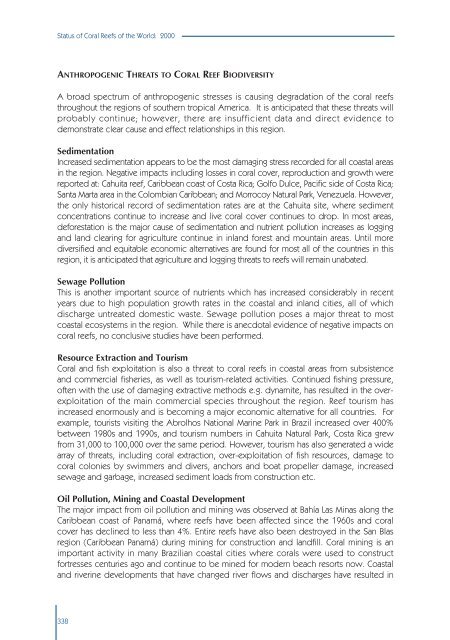Status of Coral Reefs of the World 2000
Status of Coral Reefs of the World 2000.pdf
Status of Coral Reefs of the World 2000.pdf
- No tags were found...
Create successful ePaper yourself
Turn your PDF publications into a flip-book with our unique Google optimized e-Paper software.
<strong>Status</strong> <strong>of</strong> <strong>Coral</strong> <strong>Reefs</strong> <strong>of</strong> <strong>the</strong> <strong>World</strong>: <strong>2000</strong><br />
ANTHROPOGENIC THREATS TO CORAL REEF BIODIVERSITY<br />
A broad spectrum <strong>of</strong> anthropogenic stresses is causing degradation <strong>of</strong> <strong>the</strong> coral reefs<br />
throughout <strong>the</strong> regions <strong>of</strong> sou<strong>the</strong>rn tropical America. It is anticipated that <strong>the</strong>se threats will<br />
probably continue; however, <strong>the</strong>re are insufficient data and direct evidence to<br />
demonstrate clear cause and effect relationships in this region.<br />
Sedimentation<br />
Increased sedimentation appears to be <strong>the</strong> most damaging stress recorded for all coastal areas<br />
in <strong>the</strong> region. Negative impacts including losses in coral cover, reproduction and growth were<br />
reported at: Cahuita reef, Caribbean coast <strong>of</strong> Costa Rica; Golfo Dulce, Pacific side <strong>of</strong> Costa Rica;<br />
Santa Marta area in <strong>the</strong> Colombian Caribbean; and Morrocoy Natural Park, Venezuela. However,<br />
<strong>the</strong> only historical record <strong>of</strong> sedimentation rates are at <strong>the</strong> Cahuita site, where sediment<br />
concentrations continue to increase and live coral cover continues to drop. In most areas,<br />
deforestation is <strong>the</strong> major cause <strong>of</strong> sedimentation and nutrient pollution increases as logging<br />
and land clearing for agriculture continue in inland forest and mountain areas. Until more<br />
diversified and equitable economic alternatives are found for most all <strong>of</strong> <strong>the</strong> countries in this<br />
region, it is anticipated that agriculture and logging threats to reefs will remain unabated.<br />
Sewage Pollution<br />
This is ano<strong>the</strong>r important source <strong>of</strong> nutrients which has increased considerably in recent<br />
years due to high population growth rates in <strong>the</strong> coastal and inland cities, all <strong>of</strong> which<br />
discharge untreated domestic waste. Sewage pollution poses a major threat to most<br />
coastal ecosystems in <strong>the</strong> region. While <strong>the</strong>re is anecdotal evidence <strong>of</strong> negative impacts on<br />
coral reefs, no conclusive studies have been performed.<br />
Resource Extraction and Tourism<br />
<strong>Coral</strong> and fish exploitation is also a threat to coral reefs in coastal areas from subsistence<br />
and commercial fisheries, as well as tourism-related activities. Continued fishing pressure,<br />
<strong>of</strong>ten with <strong>the</strong> use <strong>of</strong> damaging extractive methods e.g. dynamite, has resulted in <strong>the</strong> overexploitation<br />
<strong>of</strong> <strong>the</strong> main commercial species throughout <strong>the</strong> region. Reef tourism has<br />
increased enormously and is becoming a major economic alternative for all countries. For<br />
example, tourists visiting <strong>the</strong> Abrolhos National Marine Park in Brazil increased over 400%<br />
between 1980s and 1990s, and tourism numbers in Cahuita Natural Park, Costa Rica grew<br />
from 31,000 to 100,000 over <strong>the</strong> same period. However, tourism has also generated a wide<br />
array <strong>of</strong> threats, including coral extraction, over-exploitation <strong>of</strong> fish resources, damage to<br />
coral colonies by swimmers and divers, anchors and boat propeller damage, increased<br />
sewage and garbage, increased sediment loads from construction etc.<br />
Oil Pollution, Mining and Coastal Development<br />
The major impact from oil pollution and mining was observed at Bahía Las Minas along <strong>the</strong><br />
Caribbean coast <strong>of</strong> Panamá, where reefs have been affected since <strong>the</strong> 1960s and coral<br />
cover has declined to less than 4%. Entire reefs have also been destroyed in <strong>the</strong> San Blas<br />
region (Caribbean Panamá) during mining for construction and landfill. <strong>Coral</strong> mining is an<br />
important activity in many Brazilian coastal cities where corals were used to construct<br />
fortresses centuries ago and continue to be mined for modern beach resorts now. Coastal<br />
and riverine developments that have changed river flows and discharges have resulted in<br />
338
















